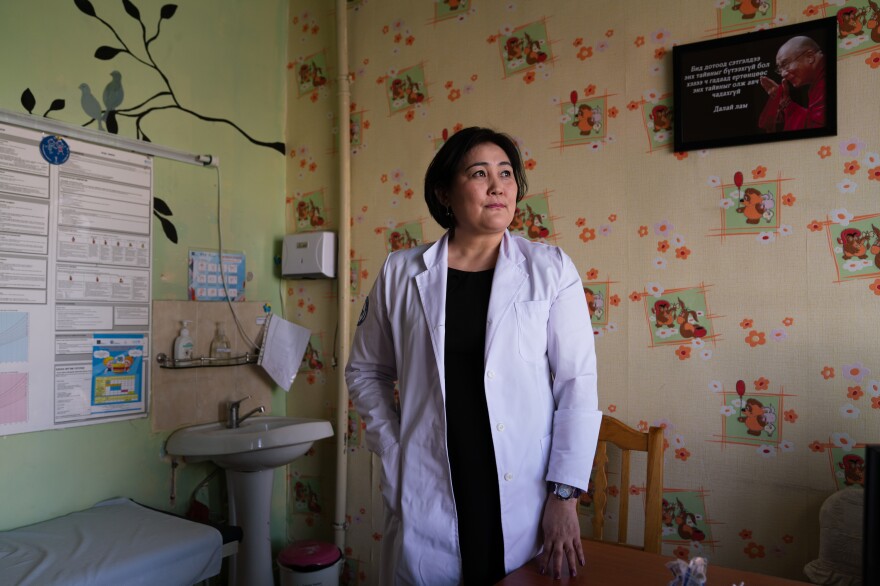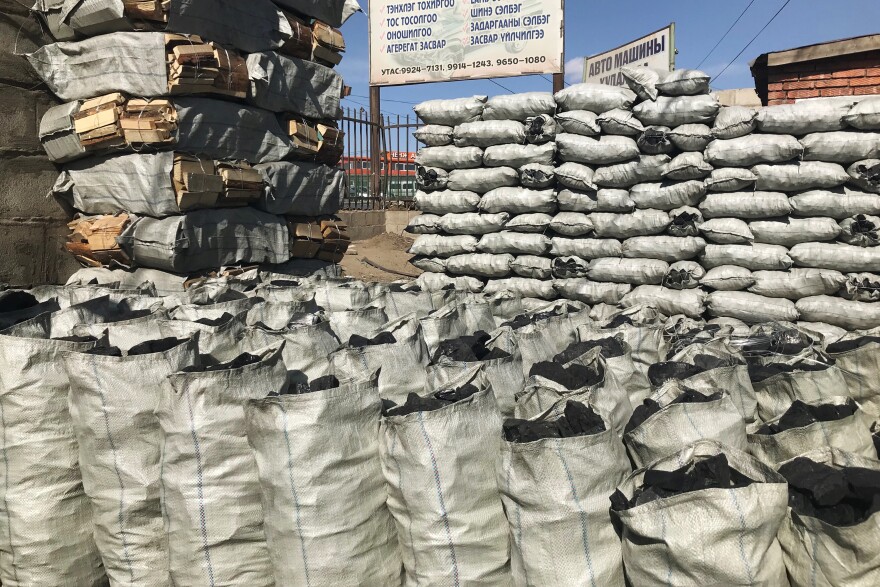Welcome to the coldest capital city on earth — Ulaanbaatar, Mongolia — where the temperature can drop to minus 20 degrees Fahrenheit at night. The city's population has nearly tripled since 1989. Without infrastructure to service all 1.4 million people, residents off the electric grid are burning raw coal to stay warm.
The result? Winters with extreme air pollution.
Loading...
Air quality correlates with the thermostat. When temperatures drop, the streets grow hazy. City dwellers walk with their heads down well into February, noses buried in jackets and face masks. The air pollution stings their eyes and perfumes their clothes with an acrid, rotten egg smell. Coal dependence is wreaking havoc on Mongolians' health.
From above, the smog appears to settle like a low-lying cloud. From below, the typically blue sky — which Mongolians worship — cannot be seen. Skyscrapers are indistinguishable, ghostly forms obscured by a blanket of gray.

The causes go beyond household coal: emissions from the city's coal-fired power plants; motor vehicle exhaust from hundreds of thousands of cars.
Geography has a role to play too. Ulaanbaatar's location — at the bottom of a valley — creates a thermal inversion effect. A layer of cool air gets trapped below a layer of warm air, keeping pollutants near the ground. Similar conditions exist in Salt Lake City.
Don't see the graphic above? Click here.
Climbing a hill for a bird's-eye view of Mongolia's capital makes that clear. But it reveals something else too: Upwards of 80% of the pollution comes from a single part of the city, known as the ger district.
Gers are circular, one-room homes made of felt wrapped around a wooden frame. Able to be disassembled in less than an hour, gers are used by herders to move from place to place. A chimney pokes through a flap at the top.
Not everyone who lives in the ger district lives in a ger. But for those who do, researchers estimate that 200,000 gers burn 600,000 tons of raw coal every winter to stay warm.

It's been this way for over a decade, giving rise to occasional protests lambasting the government and demanding action. On May 15, the city implemented — for the first time in history — a ban on raw coal use.
But will that make a difference? Winter will be a test.
Staying warm in a ger, off the grid
Perched on a foundation of tires, the home of 46-year-old Chantsal Vaanjir is a cozy oasis on a February afternoon. Outside, it's 20 degrees Fahrenheit. But inside, the coal fire crackles and fills the ger with warmth. The stove is used for both heating and cooking.

Chantsal — Mongolians go by their first names — moved to Ulaanbaatar from the rural province of Selenge in 2001. The former herder lost the family's livestock during an extreme Mongolian winter weather disaster known as a dzud. Underpinning the rise in pollution is mass rural-urban migration.
"It's difficult to live here because of the air pollution. But life is more difficult in the countryside because there are no paid jobs," she says.
As Chantsal prepares mutton dumplings for lunch, her children watch TV. The family siphons electricity from a nearby power pole in the street. But like most of the ger district, the family lives without centralized heating, water and sewage.
Raw coal is the most affordable option. The black bricks are cheap and plentiful, sold in 33-pound bags on the street for about 3,000 Mongolian tugriks ($1.13). But coal dependence comes at a price. Chantsal insists her children wear protective face masks when they go outside. She fears it's not enough.
"Smoke is still seeping through their breathing masks, even when I put a scarf over them," Chantsal says, crinkling her brow. "The inside of their masks are black and full of soot."

Air pollution as a public health problem
The human lungs act as a filter to protect the body. Exposure over time creates serious health problems, especially for children. Toddlers breathe twice as quickly as adults. Infants, even more so.

Chantsal nearly lost her son to respiratory infection last winter. In December 2018, her 6-year-old, Altanshagai Dorjsuren, was diagnosed with double pneumonia. Doctors blamed it on the air pollution. Curled up on his mother's lap, Altanshagai recounts that time.
"Here it got painful," he says, pointing to his chest. He's the opposite of shy, wanting to listen to the family's green-eyed cat through the NPR headphones.
"When he was sick," Chantsal says, "his lungs sounded just like that cat." The air sacs in both lungs were filled with fluid. To the human ear, it sounded like purring. "The hospital said his lungs were not working properly," Chantsal says.
Altanshagai recovered with medicine and bed rest. But many children do not. Pneumonia is the second-leading cause of death for children under age 5 in Mongolia.
The most dangerous pollutants are fine particles, called PM2.5, tiny enough to slide past lung tissue deep into the bloodstream. In late January 2018, Ulaanbaatar made international headlines when one government-installed sensor reported a PM2.5 concentration of 3,320 per cubic meter. That level was 133 times what the World Health Organization considers safe.
Such an extreme is rare, but the norm — unhealthy air for months at a time — is far more troubling. To protect lungs, parents send their youngest to live with relatives in the countryside. They reunite in spring, back in the city, when the air improves. Shops sell foamy "oxygen cocktails," despite the lack of scientific evidence they fortify the lungs.
In this way, air pollution is more than a nuisance. It's a public health problem that defines daily routine.

Working on the front lines in a toxic city
Doctors see the impact up close and hear it through their stethoscopes.
Last winter, a report by UNICEF Mongolia deemed the situation a "child health crisis." In the past decade, the incidence of respiratory illness across Ulaanbaatar has increased 2.7-fold per 10,000 people. Unborn children are affected too. A study at one hospital calculated a 3.6-fold increase in miscarriage incidence between May and December 2011, strongly correlated with air pollutants.
At the Bayanzurkh Medical Center in Ulaanbaatar, patients pack the hallways. Simple flus are becoming serious respiratory illnesses. Chronic diseases like bronchitis and asthma are pulling kids out of school and their parents out of work to care for them.
Pediatrician Enkhzul Jargal, 50, the center's director, considers pollution a violation of children's rights. "Disease is not for the children because they're not doing any bad things. Just growing," Enkhzul says.

The government has pledged significant funding to clean up the air — the equivalent of $55 million since 2008, according to the official state news agency Montsame — but little has changed. With support from the World Bank, the government distributed low-emission stoves a few years ago, but that program fizzled out in 2015.

Enkhzul says hospitals are basically hamstrung, discharging patients into the very environment that made them sick in the first place.
"I hate it," she mutters. "It's so stupid."
Breaking the status quo on household fuel
At the tail end of this winter, the government took a dramatic step: In March, it decided to ban raw coal. Household offenders will be fined 300,000 tugriks ($113), while large businesses will be fined 3 million tugriks ($1,134).
"People are tired of this pollution now. We love our city, so everybody needs to chip in," says Ulziibayar Gonchig, 35, the head of strategic planning for Ulaanbaatar's governor.
In light of the ban, the government is putting an alternative product on the market made from semicoke, a byproduct of coal. While more expensive, these fuel-efficient briquettes are said to burn twice as long and emit far less fumes.

When it comes to the air Mongolians breathe, Ulziibayar acknowledges a class distinction: Families contributing to air pollution the most are those least able to escape it. Wealthier Mongolians like himself can afford an at-home air filter or an insulated apartment.
Moreover, he rejects the idea that those in the ger district must choose between breathing and warmth. "They have to live. They have to burn something. They have to make heat in order to cook and feed themselves. So, we'll compensate them," he says.
The government has pledged to distribute 600,000 tons of briquettes at 1,000 selling points throughout the city, supplying the product to already existing coal sellers and putting another fuel option on the market. Ulziibayar tells the many skeptics, "Just bear with us. Next year will be much easier. People will understand where to get these coals, how to use them, and what kind of stove they're going to use. It's for all of our benefit."
NPR followed up with Chantsal, the mother whose son nearly died of pneumonia, to ask whether she would convert fuel sources this winter. "Only if the briquettes are affordable and as easily available as coal," she replied. "If not, I will not buy it."

The municipal government is pushing another big idea: to extend infrastructure to the ger district.
Backed by the Asian Development Bank, the ger areas development project is piloting services in Bayankhoshuu and Selbe — two of the most polluted neighborhoods in the city. The hope is that one day, residents won't have to rely on coal at all.

That reality seems distant, but project leader Boloroo Naranbaatar, 43, is determined. "I like challenges. Get it done. You fail? Then you try again. If it's success, then you get a compliment," quips the lifelong A-student. "I guess it's how my parents raised me."
Boloroo is equally motivated by compassion for those in the ger district. "People are tired of living like this," she says.
The ger development project is getting attention in Bayankhoshuu. There, her team has etched out the makings of a road, housing and job training center and successfully opened a 240-capacity kindergarten. Air filters on full blast, students do theater games in the morning and eat steamed dumplings for lunch.
For Boloroo, the quality of the air in the ger district is linked to quality of life for its residents. "When [residents] have a better life, a better income, it's more likely they'll improve their living conditions," she says.

After years of government promises without delivery, it's piecemeal work to earn public trust. The kindergarten, she hopes, is visible proof that things can change in Mongolia's ger district. "At least it gives the community hope that this area is going to develop," she says.
Seeing is believing when it comes to Ulaanbaatar's air pollution. Realities must change on the ground if there's any hope of seeing changes in the air.
This is part of a series by Emily Kwong (@emilykwong1234), who spent nine weeks reporting in Mongolia as NPR's Above the Fray fellow. Additional reporting and translations were provided by Ganbat Namjilsangarav. The fellowship is sponsored by the John Alexander Project, which supports foreign reporting in undercovered parts of the world. Follow the fellowship on Instagram (@thejohnaproject) and Twitter (@thejohnaproject).
Copyright 2023 NPR. To see more, visit https://www.npr.org.



